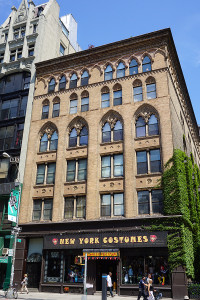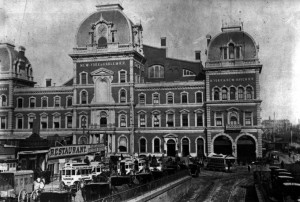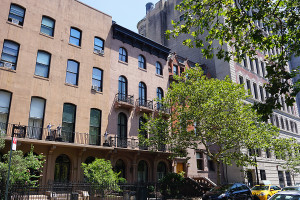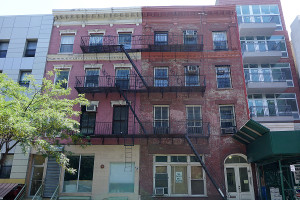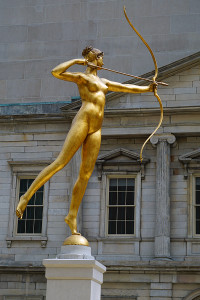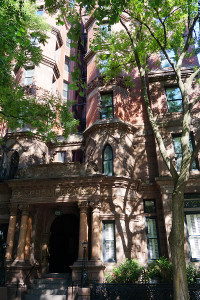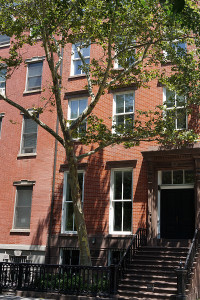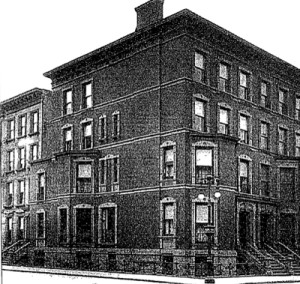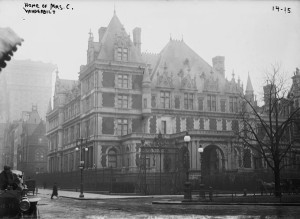The following page contains addresses, descriptions, and general historical information (where appropriate) for the New York City locations featured in The Alienist and The Angel of Darkness. The house and office locations are listed by the surname of the owner of the building/apartment, with the exception of 808 Broadway which is listed first due to its importance in the Alienist books. The locations that are not houses or offices are listed by the name of the location. For more information about key locations featured in the Alienist books that are not based in New York City, or for historical maps of these locations, please use the side menu. If you would like more information on the plots of the Alienist books, characters in the Alienist books, or general historical information relating to the time period the Alienist books are set in, please refer to the main menu above.
Investigation Headquarters
Address: 808 Broadway, New York, NY
Featured in both The Alienist (see map) and The Angel of Darkness (see map)
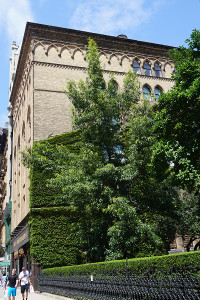
The Alienist, 119-20:
I was lying on some sort of divan, which I would have dated as early nineteenth century. Its green and silver covering matched several chairs, as well as a sofa and love seat, that were nearby. On one long, inlaid mahogany dining table stood a silver candelabra, next to which was a Remington typewriter. This incongruity was echoed in the room’s wall hangings: Across from my divan, an ostentatiously framed oil view of Florence hung next to an enormous map of Manhattan that was encrusted with several pins. The pins bore small red flags. On the opposite wall was a large chalkboard, notably blank, and beneath this black patch sat the most substantial of the five clerical desks, which together formed a ring at the outer perimeter of the room. Large fans hung from the ceiling, and two enormous Persian carpets, with elaborate designs against a deep green background, covered the center of the floor.
Within this main parlor and living area, there is an ornately carved billiard table and a baby grand piano not mentioned in the quote. The apartment also contains a kitchen. Although the furnishings of the apartment remain the same during The Angel of Darkness, Miss Howard has rearranged the furniture to make the office more appealing to her female clientele (e.g., covering the billiard table with planking and silk drape).
John Beecham’s Residence
Address: 119 Baxter Street, New York, NY
Featured in The Alienist (see map)
The final residence of John Beecham in The Alienist is located on 119 Baxter Street. The address is a tenement building on the Lower East Side where Beecham rents a flat on the top floor at the back of the property. The flat is described as no wider than a narrow hallway, with a simple partition, stove, and doorway dividing the space in half. There are no windows, and only two small chinks in the side walls provide airshafts into the neighbouring flats. The flat is extremely sparsely furnished, with only a few pieces of furniture including an old desk, chair, bed, and no sanitary facilities except for a rusted bucket. Above the desk, a map of the New York City water supply system is pinned, while the desk houses a small wooden box that has an old daguerreotype created by Beecham’s father affixed to the lid and contains the preserved remnants of Beecham’s mother’s heart. A large glass jar containing dozens of eyes preserved in formaldehyde is also present.
Franz Boas’s Office
Address: American Museum of Natural History, New York, NY
Featured in both The Alienist (see map) and The Angel of Darkness (see map)
In order to obtain further information about the possible connection of Native American tribes to the murders within The Alienist, John Moore and Dr. Kreizler briefly visit Franz Boas’s office at the American Museum of Natural History. During the time in which the book is set, Dr. Boas was working in the Natural History’s Department of Anthropology and his cluttered office was located in a museum turret overlooking Seventy-seventh Street. After talking briefly to Dr. Boas about the case, John and Dr. Kreizler were directed to one of his colleagues, Dr. Clark Wissler, who was in the process of installing an exhibit downstairs in the museum.
Grand Central Depot
Address: 42nd Street and Park Avenue, New York, NY
Featured in The Alienist (see map)
Within The Alienist, Dr. Kreizler and John Moore take a brief trip to Washington D.C. via a train departing from the Grand Central Depot to search for further clues about John Beecham’s life prior to his arrival in New York City. The precursor to New York’s current Grand Central Terminal, the Grand Central Depot was the largest train station in the country at the time it was built in 1871 by Cornelius Vanderbilt, and covered an area of 37 acres stretching between 42nd and 48th Streets, and from Lexington to Madison Avenues.3,4 At the time of the depot’s opening, 42nd Street was the northernmost edge of the city and took 45 minutes by trolley to travel to from the central business district.4 With rural homesteads and grazing animals visible across the street from the depot, critics complained that the new station was “neither grand nor central”.3 Nevertheless, 42nd Street was the closest point that the depot could be constructed due to a law passed in the mid-1850s forbidding passenger trains to pass any further into the city.3,4
The station proper, an attractive French Second Empire style building designed by John B. Snook, serviced the three major rail lines in New York at the time — the New York Central and Hudson River Railroad, the New York and Harlem Railroad, and the New York, New Haven, and Hartford Railroad — with each maintaining their own waiting, baggage, and ticketing facilities in three separate towers of the building. Mansard caps topped each tower and displayed the name of the train line on their upper facades.4 Located behind the L-shaped station proper was an immense train shed more than 652 feet long that became the second most popular tourist attraction in the United States. Inspired by London’s Paddington Station, this engineering marvel, with an arched glass and wrought iron ceiling 112 feet high, contained 12 tracks separated by raised platforms. At night the glass ceiling was illuminated by gas lamps, giving the structure an otherworldly glow.3,4
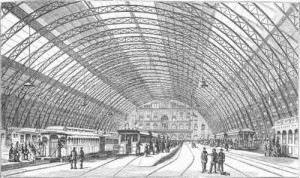
Even with the 1898 renovation, the facilities offered by depot were considered inadequate to the demands of the ever-expanding city. Customer service was poor and crime within the station was high.4 Moreover, although the lowering of the tracks had eliminated the problems associated with the original open tracks, they had created an even deadlier problem: the smoke-filled tunnels had extremely poor visibility.3,4 In 1891, the first head-on collision of commuter trains took place, resulting in passengers being trapped and burnt alive under the wreckage.4 When the tragedy was repeated in 1902, with a passenger train from New Rochelle crashing full-speed into a stopped train from Connecticut, the city put forth a requirement that all tracks become electrified.3,4 This was the final straw for the outdated depot, and a proposal to build a new $35 million station in the depot’s place was advanced that completely separated pedestrian, train, subway, and automobile traffic.2,4
Eleven years later, New York’s current Grand Central Terminal was opened in the original depot’s place. Although Cornelius Vanderbilt did not live to see the new magnificent Beaux Arts station, the Vanderbilt family retained control over the railroad until the 1950s when preservationists prevented the family from demolishing the terminal.4
Hickie the Hun’s Residence
Address: Monroe Street, New York, NY
Featured in The Angel of Darkness (see map)
In order to borrow a ferret to help locate Ana Linares within The Angel of Darkness, Stevie Taggert visits his friend, Hickie the Hun, whose home is located “in one of the oldest and worst sections of shantytown in the city” (AoD 207). Hickie lives in a dark basement of a decrepit wooden building that can be accessed via a set of old stone steps in a back alley off the street. As the basement only has one high, dirty window at the front, Hickie uses a kerosene lamp inside the basement to provide light. Although the interior of the basement is described as containing minimal furniture, it is far from sparse; it is packed with a wide variety of animals ranging from dogs and cats to raccoons and even a snake. The ferret cage sits atop a huge pile of old trunks, and is borrowed by Stevie along with the ferret for a period of a week mid-way through the investigation.
Mitchell Harper’s Office
Address: 967 Twenty-Second Street, New York, NY
Featured in The Alienist (see map)
While searching for John Beecham’s previous employers within The Alienist, John Moore and Miss Howard visit Mitchell Harper’s Accounts Settled office. The small office is located in a triangular group of buildings on the cobble-stoned pavement of Twenty-second Street. The buildings are covered with large advertising signs for a wide variety of services, making the small gold-leaf lettering on the window indicating the Accounts Settled office stand out. In contrast to the elegant gold lettering of his sign, however, Mr. Harper’s small office is sparsely furnished and covered in soot. Fortunately, Sara and John do not need to spend long in the location to obtain the information they desire, and the office is therefore not described in any greater detail.
Libby Hatch’s Residence
Address: 39 Bethune Street, New York, NY
Featured in The Angel of Darkness (see map)
In their search for Ana Linares within The Angel of Darkness, the team visit Libby Hatch’s residence at 39 Bethune Street on more than one occasion. The house is located off Greenwich Street within sight of the Hudson River, and is described within the book as, “a three-story, red brick job, with a few window boxes full of what looked like they were trying hard to be flowers” (AoD 155). The house has a small backyard surrounded by a ten-foot brick wall, and contains “flagstone walkways and a few flower and herb patches, along with some struggling ivy on the brick wall” (A 225). There are iron bars on the windows at the back of the property where the kitchen is located, and Stevie Taggert breaks into the house through these windows after the bars are removed on the team’s second attempt to locate Ana within the property.
The kitchen is described as unclean, with a stale odor in the air. An uncovered bucket filled with garbage stands in one corner, and the pots and pans that hang over the stained sink are described as covered with a layer of grease. A narrow hallway links the kitchen and the front room, and a doorway cut under the front staircase leads to the basement. The front room is described as being “furnished with just a few old items: an easy chair, a sofa, and a rocker. A beat-up wooden mantelpiece stood over the small fireplace, and a dusty, stained rug covered the floor” (A 226-7). To the left of the room’s doorway is a cheaply veneered secretary, and Stevie picks the lock to the lower half in order to locate a number of papers relating to a male child. The top half of the secretary contains a few books and old photographs; the latter are primarily of infants, but there is also a group portrait of three older children.
The basement has a concrete floor and only appears to contain a furnace, a load-bearing brick dividing wall, cabinets with old cans of paint, rusty garden tools, old chairs and a table, a small collection of empty picture frames, and a “big wooden rack full of jars of preserves” (A 228). However, following a final confrontation with Libby at the conclusion of the book, it is revealed that located below the wooden rack is a three-foot-square hole in the stone floor that leads to a narrow passageway. This passageway leads to a chamber located below the backyard that houses a hidden, beautifully furnished nursery, decorated in shades of gentle pink and white, and containing mountains of toys, a false window with a pretty country scene painted behind the glass, a fine oak rocking chair, and a handsome crib.
Dr. Laszlo Kreizler’s Residence
Address: 283 East Seventeenth Street, New York, NY
Featured in both The Alienist (see map) and The Angel of Darkness (see map)
Within the books, 283 East Seventeenth Street is Dr. Kreizler’s residence and it acts as a setting for a lot of what happens in the stories. It is a brick and stone townhouse, and is directly across the road from Stuyvesant Park. It has a small front yard enclosed by a short iron fence. Next door to the house is the Doctor’s small carriage house. Much of the interior of the house is described as being elegant with a “collection of contemporary and classic art and splendid French furniture” (A 88). The furniture and fabrics that outfit the house appear to be primarily in colours of blue, green, and silver. For instance, covering stairs is a blue and green Persian carpet. More detailed descriptions of each room are included below.
Examination Room: This is described as a small room on the ground floor containing glass cases of medicine, nursing bottles, and other medical equipment. The Doctor does not use it in either of the books, therefore suggesting that he may have only used it for consultation in the years before he opened the Institute.
Parlor: Located on the second floor, the parlor contains a grand piano and a marble mantle piece. It has french doors leading out onto a balcony that overlooks Stuyvesant Park.
Study: Located on the third floor, the study is a dark-panelled room that is extremely messy most of the time. Piles of books cover the floor, tables, and shelves.
Master Bedroom: Also located on the third floor, the master bedroom contains a four-poster bed covered with a thin, deep blue spread. The bed has lots of soft goose-down pillows. On the divan, underneath windows that overlook the park, sits a green-and-silver Chinese satin comforter.
Upstairs Bedrooms: Otherwise known as the servants’ quarters, these rooms on the fourth floor are plain in comparison to the rest of the house. Stevie Taggert’s bedroom has blue-and-white striped wallpaper, simple yet comfortable furniture, and dormered windows.
Kreizler Institute for Children
Address: 185 – 187 East Broadway, New York, NY
Featured in both The Alienist (see map) and The Angel of Darkness (see map)
Dr. Kreizler founded his Institute in 1885. It is here that he helps troubled children from all socio-economic backgrounds by taking them off the streets or out of abusive home environments, and providing them with schooling and rehabilitation. In addition, the Doctor conducts a large amount of his developmental research at this location. The upkeep of the Institute is financed by the fees charged to wealthier parents in addition to the large income he receives as an expert legal witness.
Physically, the Institute is described as occupying two four-story red-brick buildings with black-trim on East Broadway, the interiors of which were remodelled by the Doctor to become one unit. The main entrance, fronted by black iron stairs, is located at Number 185 and opens onto the second floor. This floor contains a small vestibule, front hall, consulting room, examination room, and psychological laboratory. Detailed descriptions of these rooms are included below.
Vestibule and Front Hall: Two long low benches flank the walls of these rooms, providing seating for prospective children and their parents as they wait to consult with Dr. Kreizler. The walls are painted white and have dark wood wainscoting.
Consulting Room: Contains an ornate secretary that is lighted by “a small Tiffany desk lamp of muted green and gold glass” (A 68). A small bookshelf sits near the secretary and contains book volumes that the Doctor uses to instruct parents on proper care of their children. The rest of the furnishings were specifically chosen not to be intimidating as this is the first room the children are exposed to at the Institute. The walls are decorated with paintings of animals and a variety of toys are also present. In addition to reassuring the children, Dr. Kreizler uses them to examine “agility, reaction time, and emotional disposition” (A 68).
Examination Room: Attached to the consulting room, the examination room contains Dr. Kreizler’s medical instruments. It is here that he performs physical investigations if a case interests him. As the Doctor is only interested in taking on children who have mental or emotional disorders that are not secondary to physical abnormalities, these tests ensure that a child is suitable for enrolment at the Institute.
The top floor of the Institute contains the children’s dorms, while the third floor contains school rooms and recreational halls. An operating theatre is located on the ground floor and is used for the occasional post-mortem and brain dissection. This room can be accessed from a courtyard that is located behind the building. Within the books, the interior of the operating theatre is described as follows.
The Alienist, 72:
A dark, dank hallway led us to the operating theatre, a very long room that was kept dry and warm by a gas space heater that hissed in one corner. The walls were smooth and whitewashed, and white cabinets with glass doors ran along each wall, holding a collection of gruesome, glistening instruments. On white shelves above these were a collection of chilling models: realistically painted plaster casts of human and simian heads, with their skulls partly removed to reveal brain positioning and their faces still expressive of their death throes. Sharing the shelf space with these was a large collection of actual brains from a wide variety of creatures, housed in specimen jars full of formaldehyde. The remainder of the wall space was occupied by charts of human and animal nervous systems. In the center of the room were two steel operating tables, with channels for draining bodily fluids running down the center of their beds to the foot, where they emptied into steel receptacles on the floor.
Madison Square Garden
Address: 26th Street and Madison Avenue, New York, NY
Featured in The Alienist (see map)
When John Moore suspects Dr. Kreizler of forming an attachment to Sara Howard in The Alienist, he takes pity on Dr. Kreizler’s housekeeper, Mary Palmer, who he knows is in love with the Doctor, by taking her out for the day to Koster & Bial’s Theater before dining with her at Madison Square Garden. Originally a railroad warehouse that was abandoned when the Grand Central Depot was built by Cornelius Vanderbilt in 1871, P. T. Barnum converted the building to the “Monster Classical and Geological Hippodrome”, an open-air entertainment venue.5 In 1879, Cornelius Vanderbilt’s grandson, William Kissam Vanderbilt, took over the venue, re-naming it Madison Square Garden and using it primarily for sporting events. Ten years later, it was decided that the “dirty, rickety, even dangerous” venue should be demolished to make way for what would become the most impressive pleasure garden in the city from 1890 onwards that would include room for an amphitheatre that could accommodate up to 10,000 patrons, a grand concert hall seating up to 1,500 patrons, a rooftop garden theatre with space for 300 tables that could be used for evening concerts in the summer, galleries, a restaurant, and a cafe. The amphitheatre would go on to be used for all manner of live entertainment ranging from horse shows to boxing matches, and could even be flooded for water shows.3,5
The firm McKim, Mead, & White was commissioned to design the impressive new building which The New York Times described as an “imposing quadrangular structure of the order of architecture known as Italian Renaissance, of yellow pressed brick and white terra-cotta masonry, iron, and glass”. The most notable element of the design, however, was a 300-foot tower located on the corner of 26th Street that was topped by the 13-foot controversial gilded copper statue of a naked prepubescent Diana, the Roman goddess of the hunt, whose outstretched arm acted as a weather vane for citizens of the city and had been modelled on the young mistress of her sculptor, Augustus Saint-Gaudens. Fifty Edison lamps lit the sculpture at night, and guidebooks claimed that she drew as many tourists as the Statue of Liberty.6 Paid for out of the pocket of architect Stanford White6, the Diana sculpture sat atop the married 47-year old architect’s private apartments in the tower where he entertained various mistresses including, in 1901, the 16-year old showgirl Evelyn Nesbitt; an affair that would prove to be the impetus for the site to act as the setting of its architect’s murder. When Nesbitt married millionaire Harry Kendall Thaw in 1905, and Thaw found out about the affair that had taken place several years earlier, he entered the Garden’s rooftop theatre in 1906 where White had been watching the premiere of the musical Mam’zelle Champagne. While the chorus sang “I Could Love a Million Girls”, Thaw shot White three times in the head for “ruining” his wife.2,5
Financially unviable from the start, Madison Square Garden was sold in 1911 for $3.5 million, the original cost of construction, to a firm that planned to demolish the building in order to create a 25-story office building. Unable to meet mortgage repayments, the firm put off the demolition until the New York Life Insurance Company purchased it for $2 million in 1916. The building only stayed standing for another nine years; in 1925, it was finally demolished by the insurance company order to provide land for the construction of company’s new headquarters.5
John Moore’s Residence
Address: 34 Gramercy Park, New York, NY
Featured in The Angel of Darkness (see map)
Soon after the events of The Alienist, John’s grandmother passes away. Rather than staying in her house at 19 Washington Square North, John moves into an apartment in 34 Gramercy Park due to competition over inheritance of her estate, and is living at this location during The Angel of Darkness. Historically, this was the first co-operative luxury apartment building in Manhattan and was built in 1883. It is a large brownstone Victorian building whose apartments were limited to three per floor when it was built.7 In total, the building contained 27 apartments, each containing between 7 and 11 rooms, including both a bathroom and kitchen.8 Within The Angel of Darkness, John occupies the apartments on the fifth floor that face the park on the building’s north side. His apartment is described within the book as follows.
The Angel of Darkness, 20:
Mr. Moore had decorated his apartments with as much of his grandmother’s furniture as his family would let him get away with, as well as with some fine English country pieces what Dr. Kreizler had helped him select. So the place had a kind of split character about it, feeling in some spots like an old lady’s house and in others like a rugged bachelor flat. There were some seven rooms in all, arranged in a kind of crazy order that wouldn’t have made much sense in a regular house.
Mrs. Moore’s Residence
Address: 19 Washington Square North, New York, NY
Featured in The Alienist (see map)
Within The Alienist, John Moore lives with his grandmother at her house, 19 Washington Square North. Historically, this house is part of “the Row” of Greek Revival town houses which were established in the 1840s. Although these homes ceased to be the address of choice for high society following the Civil War, wealthy New Yorkers occupied the homes well into the 20th century.9 Henry James also immortalised the neighbourhood in Washington Square, a novel he wrote in 1881. Very little of 19 Washington Square North is described in detail within The Alienist, however John does describe eating breakfast in a “glass-enclosed nook” with a copper roof that overlooks his grandmother’s rose garden in the rear yard.
John Pierpont Morgan’s Residence
Address: 219 Madison Avenue, New York, NY
Featured in The Alienist (see map)
Within The Alienist, John Moore and Dr. Kreizler are abducted and taken to John Pierpont Morgan’s elegant brownstone at 219 Madison Avenue, located in the Murray Hill district, for a meeting relating to their investigation. The brownstone was covered in crawling vine, and had large bay windows overlooking the street. Within the book, the house is described as follows.
The Alienist, 297:
Marble flooring met our feet, and a simple yet spacious white stairway wound away into the house’s upper floors. Our destination, however, lay directly ahead. We passed splendid European paintings, sculpture, and ceramics—all elegantly and simply displayed, with none of that piling-on effect that families like the Vanderbilts were so appallingly entranced by—and kept moving toward the back of the house. There the butler opened a panelled door that led into a cavernous room that was dimly lit. […] The high walls of the room were panelled with Santo Domingo mahogany that was nearly black; indeed, the room was known, to the staff of the house as well as in New York legend, as “the Black Library.” Luxurious carpets covered the floor, and a large fireplace was set into one wall. More European canvases, framed in rich, ornate gold, hung from the walls, and tall bookshelves were crammed with splendid leather-bound rarities gathered during dozens of trips across the Atlantic.
The various participants of the meeting sit on luxuriantly upholstered settees located near the fireplace as well as easy chairs set near J. P. Morgan’s desk where he sits for the duration of the meeting. The property would be demolished in 1928, fifteen years after Morgan’s death, to facilitate the construction of an exhibition room and reading room known as the Annex for the Morgan Library and Museum.10
Charles Murray’s Office
Address: 135 Eighth Street, New York, NY
Featured in The Alienist (see map)
When searching for John Beecham’s previous employers within The Alienist, John Moore and Miss Howard visit the United States Bureau of Census and speak to the Superintendent, Charles Murray. The Census Bureau occupies the second and third floors of 135 Eighth Street, located within walking distance of 808 Broadway. Each floor contains four rooms, and the walls of every room are lined with wooden filing cabinets that run to the ceiling, with mobile ladders on tracks providing access to the upper contents of the cabinets. A desk is located in the center of each room, and electrical lights with metal shades provide the only light as the windows are blocked by the filing cabinets. Mr. Murray occupies the first desk on the third floor, and it is in this location that John and Sara speak to him about John Beecham.
Mrs. Piedmont’s Residence
Address: 23 Bank Street, New York, NY
Featured in The Alienist (see map)
While searching for John Beecham within The Alienist, John Moore and Sara Howard visit his former landlady, Mrs. Piedmont. Her residence on 23 Bank Street is located in a respectable middle-class area of Greenwich Village. While renting a room on the third floor of the property from Mrs. Piedmont, Beecham pretended to work in shipping, an appropriate ruse given the property’s proximity to the shipping offices, warehouses, and trucking stations that line the Hudson River in this area of Manhattan. His recently vacated room is described as being sparsely furnished with aged furniture, and had a single window that overlooked Bank Street. Under the mattress of the bed in this room, John Moore discovers the skeleton of one of Mrs. Piedmont’s cats that Beecham tortured and killed while staying in the house.
Theodore Roosevelt’s Police Headquarters Office
Address: 300 Mulberry Street, New York, NY
Featured in The Alienist (see map)
Due to his role as Police Commissioner during the events of The Alienist, Theodore Roosevelt’s office at Police Headquarters serves as a setting for an important meeting early in the novel. Located on the second-story of the building with windows that overlook Mulberry Street, his office contains a fireplace with white mantel and is dominated by a massive desk. A number of armchairs are described as being squeezed around the desk, and a large quantity of books and papers are stacked on his desk as well as resting on the floor. A tall clock resting atop the mantel of the fireplace and a small side table holding a brass telephone are the only other items that warrant mention in the room.
Theodore Roosevelt’s Residence
Address: 689 Madison Avenue, New York, NY
Featured in The Alienist (see map)
During the time period in which The Alienist was set, Theodore Roosevelt rented 689 Madison Avenue from his sister, Anna Roosevelt Cowles, who had purchased the house in 1886. The property was one of several row houses that were built on the corner of Madison Avenue and East 62nd Street in 1880.11 Historically, Madison Avenue was constructed during the 1840s and was primarily a residential area for the upper middle class until exclusive hotels, fashionable shops, and other commercial establishments began to appear in the street from the early twentieth century onwards.2
When John Moore and Sara Howard visit the row house in The Alienist, it is described as a “comfortable, well-furnished home that was nonetheless inadequate to the task of containing the antics of the five Roosevelt children” (A 383). In keeping with this, very little of the interior of the house is described, with attention focused on the various species of wildlife that the children kept, including an owl and a two-foot garter snake. Theodore’s “book-lined study” is the only room in the house that is featured, and is described as containing several desks that were covered by a number of works in progress, reference volumes, and maps.
Albert Pinkham Ryder’s Residence
Address: 308 West Fifteenth Street, New York, NY
Featured in The Angel of Darkness (see map)
While searching for a portrait artist in The Angel of Darkness, three of the team visit the reclusive Albert Pinkham Ryder at his flat in 308 West Fifteenth Street, which he occupied between 1896 and 1909.12 The building is described in the book as, “one of thousands like it in that neighbourhood: a simple old brick row house that’d been converted into flats” (AoD 98). The interior of the flat is described in the book as being littered with piles of books, newspapers, and trash in the front room, while the walls of the studio were “covered with unframed canvases that, to the untrained eye, would have looked like finished pictures: beautiful golden landscapes, stormy dark seascapes (or what the art crowd would call “marines”), as well as scenes from the poetry, drama, and myths what fascinated old Pinkie” (AoD 99).
Santorelli Family Residence
Address: Mott Street, New York, NY
Featured in The Alienist (see map)
Early in The Alienist, Miss Howard and John Moore visit Mr. and Mrs. Santorelli in their rear tenement flat on the Lower East Side to obtain information about their son, Giorgio. The filthy front tenement hallway was difficult for John and Sara to navigate as the building had no light source. After finally making their way through the back door into garbage and sewage strewn alleyway between the front and rear tenements, they locate the Santorelli’s two room flat that they share with another family on the second-floor of the rear tenement. The flat’s bare walls have no windows, and two slits provide the only ventilation. The only noteworthy items in the flat include a cheap kerosene stove, a stained mattress on the floor, and buckets in the corners that are used as sanitation facilities.
Cornelius Vanderbilt II’s Residence
Address: 1 West Fifty-Seventh Street, New York, NY
Featured in The Angel of Darkness (see map)
Within The Angel of Darkness, John Moore and Dr. Kreizler visit Cornelius Vanderbilt II’s mansion on West Fifty-Seventh Street and Fifth Avenue to obtain further information about Libby Hatch who had previously worked as a servant in his home. The original structure was built by George Browne Post between 1879 and 1882 to occupy the space of three existing brownstones, and was expanded in 1892 by Post and Richard Morris Hunt to occupy the space of a further five brownstones. Constructed from red brick and white limestone, the mansion was commissioned as a replica of a French Renaissance château and consisted of 130 rooms that contained artworks by the most famous artists of the day including John La Farge, Augustus Saint-Gaudens, and Louis Comfort Tiffany.13 In the book, John and the Doctor have their meeting with Cornelius II in the “Moorish room” at the back of the property, which is described as follows.
The Angel of Darkness, 250:
It wasn’t enough that the wood of the walls—fully two stories high—was as expensive as possible or that it was carved in more complicated patterns than the Arabian models what it’d been based on; no, the walls also had to be inlaid with other precious substances, including, if you can believe it, mother-of-pearl. […] Hanging from the high ceiling was a gigantic, bulbous Tiffany lamp, with smaller lamps, also of Tiffany glass, suspended in a circle from the top of this central fixture. Below that conglomeration, set in front of a marble Moorish fireplace and on top of several enormous, thick Persian carpets, were some straight-backed velvet chairs.
References
1. NYCJPG, “The Renwick, 808 Broadway” 2003. Link.
2. Jackson, Kenneth T., “The Encyclopedia of New York City” 1995.
3. Reiss, Marcia, “Lost New York” 2011.
4. Miller, Tom, “Daytonian in Manhattan: The Lost 1871 Grand Central Depot — 42nd Street” 4 Feb. 2013. Link.
5. Miller, Tom, “Daytonian in Manhattan: Stanford White’s Lost 1900 Madison Square Garden” 2 Mar. 2011. Link.
6. Zacks, Richard, “Island of Vice: Theodore Roosevelt’s Quest to Clean Up Sin-Loving New York” 2012.
7. New York Architecture Images, “34 Gramercy Park East” 9 Feb. 2008. Link.
8. Barr, Linda, “New York City’s oldest co-op celebrates 120th anniversary – Profile of the Week: The Gramercy at 34 Gramercy Park”, Real Estate Weekly 14 May 2003. Link.
9. New York Architecture Images, “19-26 Washington Square North” 9 Feb. 2008. Link.
10. The Morgan Library & Museum, “History of the Morgan” 2012. Link.
11. Gray, Christopher, “Streetscapes/Readers’ Questions: A Teddy Roosevelt House, a Calvert Vaux Design”, The New York Times 1 Mar. 1998.
12. New York Songline, “Fifteenth Street” 2011. Link.
13. Dannatt, Adrian, “Once This was the Grandest House in America”, Bergdorf Goodman Blog 29 Aug. 2012. Link.

